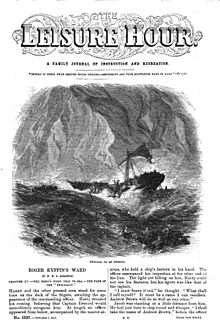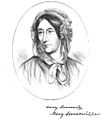The Leisure Hour was a British general-interest periodical of the Victorian era published weekly from 1852 to 1905.[1][2] It was the most successful of several popular magazines published by the Religious Tract Society, which produced Christian literature for a wide audience.[1] Each issue mixed multiple genres of fiction and factual stories, historical and topical.[1]
 The cover of issue 1032, with an illustration accompanying a story about a shipwreck. | |
| Frequency | Weekly |
|---|---|
| Publisher | Religious Tract Society |
| First issue | January 1, 1852 |
| Country | United Kingdom |
| Based in | London |
| Language | English |
| OCLC | 362165421 |
The magazine's title referred to campaigns that had decreased work hours, giving workers extra leisure time.[3] Until 1876, it carried the subtitle A Family Journal of Instruction and Recreation;[4] after that, the subtitle changed to An illustrated magazine for home reading.[5]
Each issue cost one penny and contained 16 pages.[6] The layout typically included approximately six long articles, formatted in two columns per page, and five or six illustrations. The articles were a mix of biographies, poetry, essays, and fiction. Each issue usually started with a piece of serialised fiction.[6]
The creation of the magazine was partly a response to non-religious popular magazines that the Religious Tract Society saw as delivering a "pernicious" morality to the working classes.[1] The ethos of the magazine was guided by Sabbatarianism: the campaign to keep Sunday as a day of rest.[4] It aimed to treat its diverse subjects "in the light of Christian truth".[4] Despite this, The Leisure Hour carried far fewer statements of Christian doctrine than the Society's other publications,[6] and had a greater emphasis on fiction than popular magazines of the time.[7]
Two days before the magazine's launch in 1852, a warehouse fire destroyed the first batch of The Leisure Hour, so replacement copies had to be printed.[3]
The magazine was edited by William Haig Miller until 1858,[5] James Macaulay from 1858 to 1895,[8] and William Stevens from 1895 to 1900.[5] Harold Copping was one of its illustrators.[9] Authors were initially only credited by initials rather than by name, giving the writing a collective rather than individual authority, though naming of authors became more common from the 1870s.[1] In its jubilee issue, published in 1902, the magazine identified 111 authors who had contributed.[1]
Notable contributors
Gallery of illustrations
- John Keble, 1867
- Mary Somerville, 1871
- Charles Dickens, 1904
- “A Vision of the Future. An aërial motor-car”, 1905
References
Further reading


- Palmegiano, E. M. (15 October 2013). Perceptions of the Press in Nineteenth-Century British Periodicals: A Bibliography. Anthem Press. pp. 329–352. ISBN 978-1-78308-053-3.



